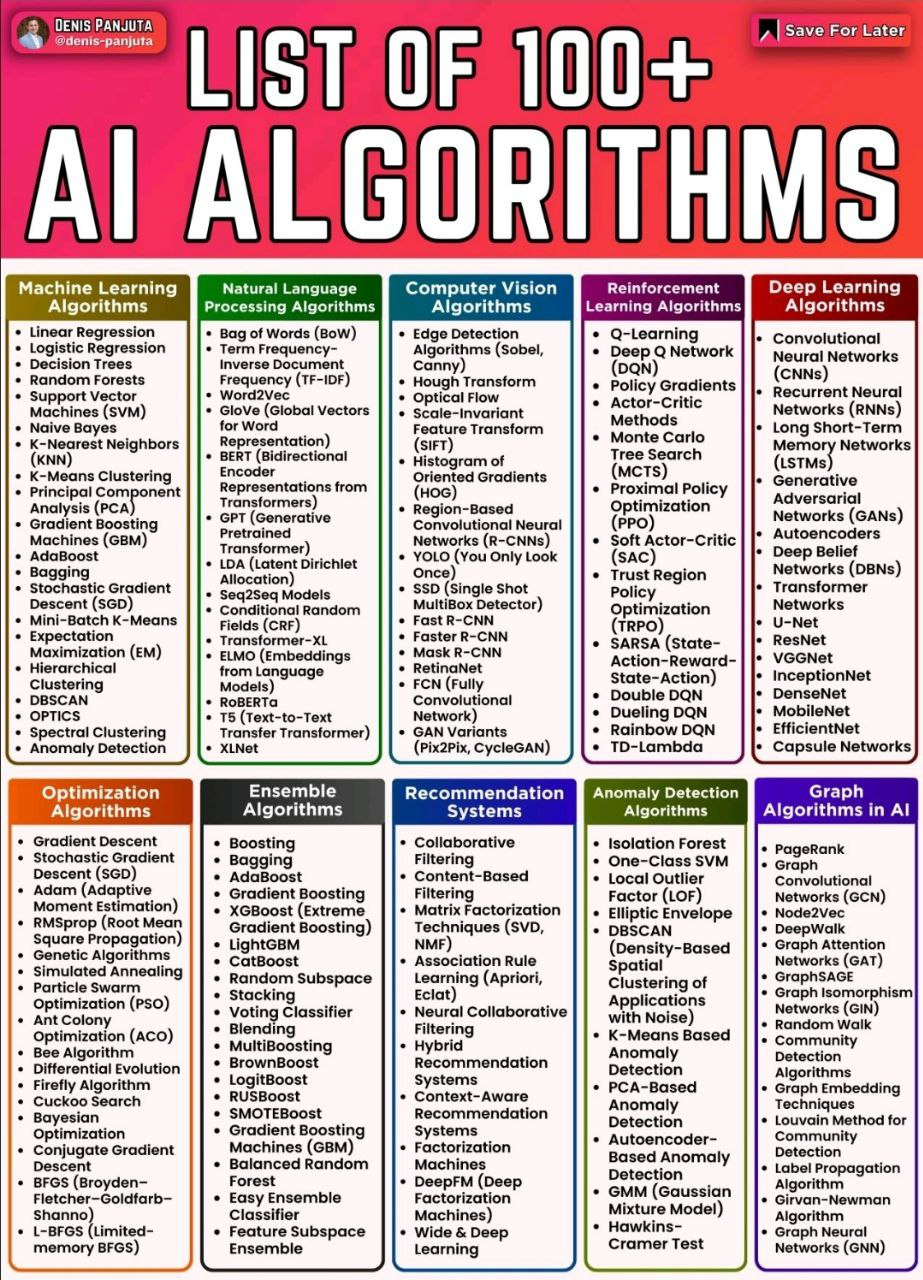This post related to :
List of top 100 AI algorithms
Below is a list of AI algorithms discovered in the LinkedIn post.
All algorithms presented on the picture below.

Retrived data from the picture:
Machine Learning Algorithms (14 algorithms)
- Linear Regression
- Logistic Regression
- Decision Trees
- Random Forests
- Support Vector Machines (SVM)
- Naive Bayes
- K-Nearest Neighbors (KNN)
- K-Means Clustering
- Principal Component Analysis (PCA)
- Gradient Boosting Machines (GBM)
- Adaboost
- Bagging
- Stochastic Gradient Descent (SGD)
- Expectation Maximization (EM)
Natural Language Processing Algorithms (12 algorithms)
- Bag of Words (BoW)
- Term Frequency–Inverse Document Frequency (TF-IDF)
- Word2Vec
- GloVe (Global Vectors for Word Representation)
- Embeddings from Language Models (ELMo)
- GPT (Generative Pre-trained Transformer)
- Seq2Seq Models
- Conditional Random Fields (CRF)
- BERT (Bidirectional Encoder Representations from Transformers)
- RoBERTa
- T5 (Text-to-Text Transformer)
- XLNet
Computer Vision Algorithms (13 algorithms)
- Edge Detection (Sobel, Prewitt, Canny)
- Hough Transform
- Scale-Invariant Feature Transform (SIFT)
- Histogram of Oriented Gradients (HOG)
- Region-Based Convolutional Neural Network (R-CNN)
- Fast R-CNN
- Mask R-CNN
- You Only Look Once (YOLO)
- SSD (Single Shot Multibox Detector)
- ResNet
- Fully Convolutional Networks (FCN)
- GAN Variants (Pix2Pix, CycleGAN)
- Optical Flow
Reinforcement Learning Algorithms (13 algorithms)
- Q-Learning
- Deep Q Network (DQN)
- Policy Gradients
- Actor-Critic Methods
- Monte Carlo Tree Search (MCTS)
- Proximal Policy Optimization (PPO)
- Soft Actor-Critic (SAC)
- Trust Region Policy Optimization (TRPO)
- SARSA (State-Action-Reward-State-Action)
- Double DQN
- Dueling DQN
- Rainbow DQN
- TD-Lambda
Deep Learning Algorithms (14 algorithms)
- Convolutional Neural Networks (CNNs)
- Recurrent Neural Networks (RNNs)
- Long Short-Term Memory (LSTMs)
- Generative Adversarial Networks (GANs)
- Autoencoders
- Deep Belief Networks (DBNs)
- Transformers
- U-Net
- ResNet
- VGGNet
- InceptionNet
- DenseNet
- MobileNet
- EfficientNet
Optimization Algorithms (14 algorithms)
- Gradient Descent
- Stochastic Gradient Descent (SGD)
- Momentum-Based Methods
- Adam (Adaptive Moment Estimation)
- RMSprop
- Simulated Annealing
- Genetic Algorithm
- Particle Swarm Optimization (PSO)
- Ant Colony Optimization (ACO)
- Bayesian Optimization
- Nelder–Mead
- Powell’s Method
- L-BFGS (Limited-memory BFGS)
- CMA-ES (Covariance Matrix Adaptation Evolution Strategy)
Ensemble Algorithms (12 algorithms)
- Boosting
- Bagging
- Random Subspace
- Stacking
- Gradient Boosting Machines (GBM)
- XGBoost
- CatBoost
- LightGBM
- Rotation Forest
- Voting Classifier
- SMOTEBoost
- Balanced Random Forest (BRF)
Recommendation Systems (10 algorithms)
- Collaborative Filtering
- Content-Based Filtering
- Matrix Factorization Techniques (SVD, ALS)
- Association Rule Learning (Apriori, Eclat)
- Neural Collaborative Filtering
- Hybrid Recommendation Systems
- Context-Aware Recommendation
- Reinforcement Learning-Based Recommendation
- Deep Learning-Based Recommendation
- Knowledge Graph-Based Recommendation
Anomaly Detection Algorithms (9 algorithms)
- Isolation Forest
- One-Class SVM
- Local Outlier Factor (LOF)
- Elliptic Envelope
- DBSCAN
- PCA-Based Anomaly Detection
- Autoencoders-Based Anomaly Detection
- GMM (Gaussian Mixture Model)
- Hawkins–Cramer Test
- Graph Algorithms in AI (8 algorithms)**
- PageRank
- Graph Convolutional Networks (GCNs)
- Node2Vec
- Graph Attention Networks (GAT)
- GraphSAGE
- Random Walk Algorithms
- Label Propagation Algorithm
- Eigenvector-Based Centrality
Table below is showing some algorithms, related information and examples that programmatically shows how it works (this task is in progress and some separated posts will be created later).